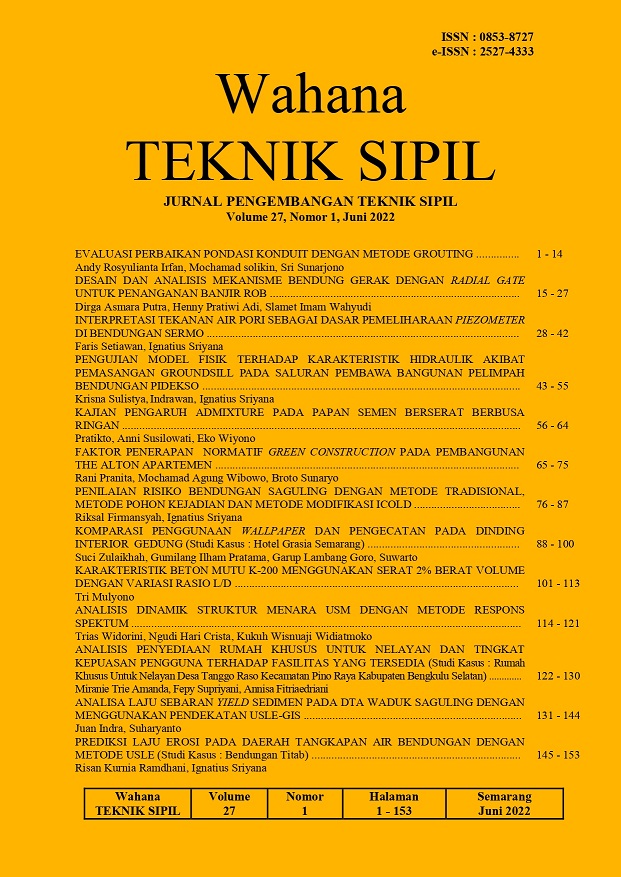EVALUASI PERBAIKAN PONDASI KONDUIT DENGAN METODE GROUTING
DOI:
https://doi.org/10.32497/wahanats.v27i1.3667Keywords:
displacement, effectiveness, Lugeon value, groutingAbstract
The Tugu Dam is one of the National Strategic Projects located in Trenggalek, East Java. Dam construction is an old practice, so history of dam shows great innovations in engineering. The innovations are not only for foundation design, but for foundation failure repairing. In the conduit of the Tugu dam, there is displacement as far as 20 mm - 60 mm. The alternative foundation failure repairing is grouting. The purpose of this study is to identify problems in the foundation failure of Conduit Tugu Dam and to evaluate the effectiveness of grouting based on the lugeon value and displacement value in the simulation by software. The results of the investigation that obtained a colovial layer as deep as 15-28 (m) in the displacement. The Lugeon Value area by testing the water pressure is 3,54 ”“ 104,13. After the grouting work is done and the water pressure test is carried out, the Lugeon value on the Check Hole is 1,01 ”“ 4,95 so that the grouting effectiveness is 75% (good category). The results using sigma/w show that displacement without using grout is -0,394 (m) alternative 1 is -0,027 (m), alternative 2 is -0,051(m), alternative 3 is -0,034 (m) and alternative 4 is -0,026 (m).References
Arsyad, M.S., 2017, Modul Pengaturan Dan Konsepsi Keamanan Bendungan, Bandung: Pusat Pendidikan Dan Pelatihan Sumber Daya Air Dan Konstruksi.
Bowles, J.E., 1997, Foundation Analysis and Design International Student Edition Third Edition, New York: Mc Graw-Hill.
Bryson, L.S., R. Ortiz, dan J. Leandre, 2014, “Effects of a Grout Curtain on Hydraulic and Electrical Conductivity in a Laboratory-Scale Seepage Model”, Geo-Congress 2014 Technical Papers 234(Geo-Characterization and Modeling for Sustainability): 3233”“42.
BSN, 2000, Tata Cara Pengontrolan Sungai Bag-1 (SNI 03-6456. 1-2000), Indonesia: Badan Standardisasi Nasional.
BSN, 2008a, Cara Uji Kelulusan Air Bertekanan Di Lapangan (SNI 2411-2008), Indonesia: Badan Standarisasi Nasional.
BSN, 2008b, Tata cara pencatatan dan identifikasi hasil pengeboran inti (SNI 2436:2008), Indonesia: Badan Standarisasi Nasional.
Budiyanto, Kadar, 2010, Pelaksanaan Grouting Bendungan Sangiran, Ngawi: Tim Pelaksanaan Boring dan Grouting Bendungan Sangiran Ngawi.
Das, Braja M., dan Khaled Sobhan, 2014, Principles of Geotechnical Engineering, Eighth Edition,SI. Stamford: Cengage Learning.
Dwiyanto, J.S., 2005, Hand Out Geoteknik, Bandung : Dep Pekerjaan Umum.
Ewert, Friedrich-Karl, dan Ulrich Hungsbrg, 2018, Rock Grouting at Dam Sites, frankfurt: Springer.
Fan, G., D. Zhong, F. Yan, dan P. Yue., 2016, “A hybrid fuzzy evaluation method for curtain grouting efficiency assessment based on an AHP method extended by D numbers, Expert Systems with Applications”, Expert Systems with Applications 44:289”“303.
Mulyono, Joko, 2017, “Konsepsi Keamanan Bendungan.” Junal Infrastruktur 3:62”“69.
Nurnawaty, Suhardiman, dan Ihwan, 2018, “Analisis Rembesan Pada Bendungan Tipe Urugan (Uji Simulasi Lab).” Jurnal Teknik Hidro 11(1):12”“22.
Pearson, R., dan S. Money, M., 1977, “Improvement in the Lugeon or Packertest Permeability test.” Q. Jl Eng Geology1 10:221”“39.
PUPR, 2015, Peraturan Menteri PUPR nomor 27/PRT/M/2015. Jakarta: JDIH Kementerian
Wahana TEKNIK SIPIL Vol. 27 No. 1 Juni 2022 1 - 14
PUPR.
PUPR, 2016, Petunjuk Teknis Pengujian Tanah, Jakarta: Direktorat Jenderal Bina Marga.
SDA, 2005, Pedoman Grouting Untuk Bendungan, Jakarta: Direktorat Jenderal Sumber Daya Air.
Skempton, A., dan D. Macdonald, 1955, “A Survey of Comparisons between Calculated and Observed Settlement of Structures on Clay”, Correlation of Calculated and Observed Stresses and Displacemen 318”“37.
Sosrodarsono, Suyono, dan Kansaku Takeda, 1977, Bendungan Type Urugan (Edisi ke-2), Jakarta: PT. Pradndya Paramita.
Sudaryanto, Eddi, 2020, Laporan Konsultan Bulan Maret, Trenggalek: Tim Konsultan Bendungan Tugu Trenggalek.
Downloads
Published
Issue
Section
License
Authors who publish with this journal agree to the following terms:Authors retain copyright and grant the journal right of first publication with the work simultaneously licensed under a Creative Commons Attribution License that allows others to share the work with an acknowledgement of the work's authorship and initial publication in this journal.
Authors are able to enter into separate, additional contractual arrangements for the non-exclusive distribution of the journal's published version of the work (e.g., post it to an institutional repository or publish it in a book), with an acknowledgement of its initial publication in this journal.
Authors are permitted and encouraged to post their work online (e.g., in institutional repositories or on their website) prior to and during the submission process, as it can lead to productive exchanges, as well as earlier and greater citation of published work (See The Effect of Open Access).






